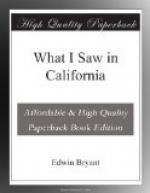It has not been within the scope of my design, in writing out those notes, to enter into the minute details of the conquest and occupation of California by the forces of the United States. To do so would require more space than I have allowed myself, and the matter would be more voluminous than interesting or important. My intention has been to give such a sketch of the military operations in California, during my residence and travels in the country, as to afford to the reader a general and correct idea of the events transpiring at the time. No important circumstance, I think, has escaped my attention.
Among the officers of the army stationed at San Francisco, with whom I became acquainted, were Major Hardie, in command of the troops, Captain Folsom, acting quartermaster-general in California, and Lieutenant Warner, of the engineer corps. Lieutenant Warner marched with General Kearny from the United States, and was at the battle of San Pasqual. I have seen the coat which he wore on that occasion, pierced in seven different places by the lances of the enemy. He did not make this exhibition himself; and I never heard him refer to the subject but once, and then it was with the modesty of a veteran campaigner.
The corps of topographical engineers accompanying General Kearny, under the command of Captain Emory, will, doubtless, furnish in their report much interesting and valuable information. Mr. Stanley, the artist Of the expedition, completed his sketches in oil, at San Francisco; and a more truthful, interesting, and valuable series of paintings, delineating mountain scenery, the floral exhibitions on the route, the savage tribes between Santa Fe and California—combined with camp-life and marches through the desert and wilderness—has never been, and probably never will be, exhibited. Mr. Stanley informed me that he was preparing a work on the savage tribes of North America and of the islands of the Pacific, which, when completed on his plan, will be the most comprehensive and descriptive of the subject of any that has been published.
Legal proceedings are much less complex in California than in the United States. There is no written statute law in the country. The only law books I could find were a digested code entitled, “Laws of Spain and the Indies,” published in Spain about a hundred years ago, and a small pamphlet defining the powers of various judicial officers, emanating from the Mexican government since the revolution. A late Mexican governor of California, on being required by a magistrate to instruct him as to the manner in which he should administer the law within his jurisdiction, replied, “Administer it in accordance with the principles of natural right and justice,” and this is the foundation of Californian jurisprudence. The local bandos, or laws, are enacted, adjudicated, and executed by the local magistrates, or alcaldes. The alcalde has jurisdiction in all municipal matters,




